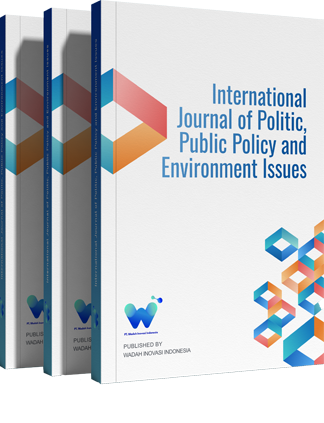Sectoral Analysis of The Economic Potential Development to Support Government Policy in Banjar District, South of Kalimantan
DOI:
https://doi.org/10.53622/ij3pei.v1i02.34Keywords:
Sectoral Analysis, Potential Development, Regional Economic, Government PolicyAbstract
The COVID-19 pandemic situation, leadership succession, and changes in the RPJMD certainly provide challenges and opportunities for local governments to maintain the existence and sustainability of economic growth. Short-term solutions are needed to help leading sectors continue to have an impact on economic growth. Identification and specific strategies in determining leading sectors are essential in a pandemic condition where the economic situation is uncertain. The purpose of this study was to determine the sector that has the potential to be a leading, competitive, and fast-growing sector in regional development in Banjar Regency during and after the Covid 19 pandemic. This study used research methods and designs starting from the Quantitative-Qualitative Research Methods. Based on the study results, the determination of the leading sector based on the calculation ranking of LQ, Shift Share, and I - O uses slices and sees the most considerable contribution to GRDP and the workforce absorbed in that sector. 3 The main sectors that excel are Wholesale and Retail Trade, Repair of Cars and Motorcycles; Provision of Accommodation and Food and Drink; Agriculture, Forestry and Fisheries. Based on the results of the AHP analysis of the respondents, it shows that the priority policy criteria are prioritized on the development of the leading economic sector in Banjar Regency, with the priority being infrastructure development, the second being institutional improvement, while the investment aspect is the third priority. The aspect of market expansion becomes the fourth priority, and the fifth and sixth priorities are the development of Special Economic Zones and aspects of sustainability. Meanwhile, the farmer or the community, the actor or party that has the most crucial role in developing the leading sector in Banjar Regency based on the respondent's choice. The Government is considered the second most crucial actor in implementing leading sector activities due to the lack of basic facilities supporting economic and trade activities. Furthermore, Social Organizations and Private Parties or Investors as other important actors in developing leading sectors in Banjar Regency
References
Regency. 2020. The Regional Government Work Plan (RKPD) of Banjar Regency in 2021. Bappedalitbang Banjar Regency
Boediono. 1995. Macroeconomics. BPFE-Yogyakarta.
BPS Banjar Regency. 2020. GRDP of Banjar Regency by Business Field 2015-2019. Martapura.
BPS Banjar Regency. 2020. GRDP of Banjar Regency by 2015-2019 Expenditure. Martapura.
BPS South Kalimantan Province. 2019. Macroeconomic Overview of South Kalimantan Province Quarter II-2020 (April-June). Banjarmasin.
BPS South Kalimantan Province. 2019. South Kalimantan GRDP by Field of Business. Banjarmasin.
BPS South Kalimantan Province. 2019. Gross Regional Domestic Product of South Kalimantan Province by Business Field 2015-2019. Banjarmasin.
BPS South Kalimantan Province. 2019.Regency_City Overview ofGRDP in South Kalimantan 2019. Banjarmasin.
Budian, N. 2014. Analysis of Development Policy Based on Leading Economic Sector (Case of Leading Economic Sector of Manufacturing Industry in Banjarbaru City). Thesis. Lambung Mangkurat University. Banjarmasin.
Hanoatubun, S. 2020. The Impact of Covid-19 on the Indonesian Economy. Edu Psy Coun Journal, Vol 2 (1), pp. 1-19.
Hendayana, R. 2003. Application of Location Quotient (LQ) Method in Determination. Leading Commodity Base Sector. Educational Informatics. Volume 7 (3).
Irawan, et al. 2008. Development Economics. Publisher BPFE Yogyakarta
Irawan. 2008. Modern MarketingManagement,.Liberty. Yogyakarta.
Banjar Regency. 2020. Profile of Banjar Regency. Learn more at https://banjarkab.go.id/profil-2/gambaran-umum-region-kab-banjar/. Retrieved October 29, 2020.
Kamim, AB et al. 2019. Negotiation of Interests in the Formulation of the 2017-2022 DIY RPJMD in the Advocacy Coalition Framework. Journal of Borneo Administrator, Vol. 15 No. 1, 81-98.
Banjar Newspaper. 2020. Simultaneous Pilkada December 9, Banjar Regency KPU: Wait for Technical Guidelines. Learn more at https://koranbanjar.net/pilkada-serentak-9-desember-kpu-kabupaten-banjar-Wait-juknis/. Accessed on November 1, 2020.
Kristiantina, DE et al. Policy Analysis of Blitar City Government in Developing Regional Potential as an Effort to Increase Regional Competitiveness. Journal of Public Administration (JAP). Vol. 1. Number 4.
Liu, W., Yue, X.-G., & Tchounwou, PB 2020. Response to the COVID-19 Epidemic: The Chinese Experience and Implications for Other Countries. International Journal of Environmental Research and Public Health, 17 (7), 2304.
Mankiw, NG 2007. Introduction to Macroeconomics. Jakarta: Erlangga.
Mankwin, NG 2008. Macroeconomics. Erlangga Publisher. Jakarta
Maulana, RF & Sulasdi, WN 2018. Analysis of the Implementation of the Development Paradigm (Economic Growth, Welfare, and Human Resources) in the Rpjmd Strategy of West Java Province in 2008-2013. SAPPK Development Studies Journal. Vol 7 (1), pp. 1-23.
Nasution, DA D et al. 2020. The Impact of the Covid-19 Pandemic on the Indonesian Economy. Benefit Journal. 5(2), pp. 212-224.
Novrilasari, D. 2008. Analysis of Leading Sector in Improving the Economy and Regional Development of Kuantan Singingi Regency. Thesis. Bogor Agricultural Institute. Bogor.
Nurlatifah, U. 2006. Analysis of Economic Structure and Identification of Leading Sector in Subang Regency. Thesis. Bogor Agricultural Institute. Bogor.
OECD. 2020. SME Policy Responses. Read more at https://read.oecdilibrary.org/view/?ref=119_119680-di6h3qgi4x&title=Covid19_SME_Policy_Responses. Accessed October 29, 2020.
Banjar Regency Government. 2005. Regional Long-Term Development Plan (RPJPD) Banjar Regency 2005 – 2025. Bappedalitbang Banjar Regency.
Pepinsky, TB, & Wihardja, MM 2011. Decentralization and Economic Performance in Indonesia. Journal of East Asian Studies, 11(3), 337–371.
Purnomowati W, Sopanah. 2014. Analysis of Sectoral Contributions to the GRDP of Malang City Towards the Concept of Balanced Growth. Widyagama University Malang.
Rostow, WW 1960. TheStage of Economic Growth: a non-communist manifesto. Cambridge: The Syndics of the Cambridge University Press.
Salim, A. 2018. Urban Poverty in Yogyakarta and Its Significance in Poverty Reduction in DIY. Journal of Planning Volume V, 1, pp 1-20.
Santoso, YI 2020. Calculating the impact of Covid 19 on the business world to MSMEs. Read more at https://nasional.kontan.co.id/news/menghitungdampak-covid-19-terhadap-dunia-usaha-untungumkm?page=all.Kontan.co.id. Accessed October 22, 2020.
Sarman, M. 2008. Introduction to Social Research Methodology. Unlam Fisip Library: Banjarmasin.
Downloads
Published
Issue
Section
Citation Check
License
Authors retain copyright and grant the journal right of first publication with the work simultaneously licensed under a Creative Commons Attribution 4.0 International License that allows others to share the work with an acknowledgment of the work's authorship and initial publication in this journal.







